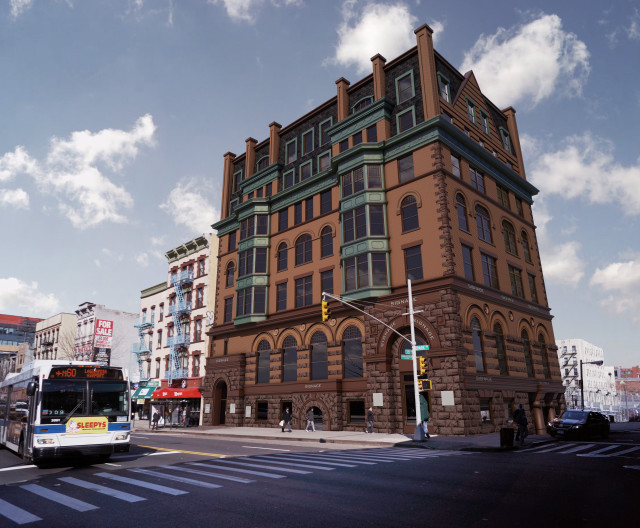
The Corn Exchange building, site of the upcoming Flux Art Fair. Image courtesy of allen/cooper enterprises.
When nobody was watching, Harlem became one of the most desirable art neighborhoods in New York. A steady influx of art galleries and non-profits have been moving into the neighborhood over the last several years. Even East Harlem seems poised for more; 2014 saw the city’s first affordable housing units, earmarked specifically for artists, go up at El Barrio’s Artspace PS109, and Hunter East Harlem Gallery, the university’s gallery located at 119th Street, recently reignited a regular schedule of exhibition and event programming after a yearlong hiatus. It’s not just the art scene that’s changing; between 2013 and 2014, Harlem’s rental prices jumped more than any other Manhattan neighborhood.
The latest sign that Harlem could soon be given a new, art-centric nickname (please, anything but hARTlem) comes in the form of the Flux Art Fair, a curator-run fair to be held in the historic—though recently crumbling, and soon-to-be renovated—Corn Exchange building. Set to coincide with Frieze art week, the fair will run from May 14 through 17. The fair’s theme, “The 21st Century Artist is a Nomad,” implies an international scope, though it’s up to the dozens of curators to choose exactly what that means. Based on the list of 54 exhibiting artists and collectives, Harlem’s own will be a large part of the fair.
They’re excited to show their neighborhood to the rest of the world.
“Harlem is going through another renaissance,” says Stan Squirewell, an artist participating in the fair, and a recent transplant from Washington, DC. “Everyone knows everyone here.” During our phone conversation, he was able to list off nearly a dozen artists he knew who were showing in the Flux Art Fair, and even where their studios are located in Harlem. He lives at 147th Street.

Stan Squirewell, “The Vast Nothingness,” 2014. Image courtesy of Art in Flux.
That’s far off from the Corn Exchange building, which sits at 125th. The hugeness of Harlem makes any generalizations about the neighborhood unwieldy, but for those who are new to the area, the Corn Exchange building might be a good start.
“Its just a 10-minute taxi ride from Frieze,” says fair founder Leanne Stella. No stranger to Harlem, Stella has been running pop-up art events with in the neighborhood since 2011—and she lives there, too.
“It’s a beautiful neighborhood, with churches and brownstones,” says Stella. “I think people will be pleasantly surprised.”
As for the fair itself, we have real-estate development to thank for the event’s existence. (Originally built in 1883, by the 1970s the Corn Exchange building was in shambles, vacated. It fell into ownership of the city. It wasn’t until 2013 when Artimus Construction was granted city approval to build a new, $14-million structure for offices and residences.)
For nearly a year, Stella had been searching for a building that would house an art fair. With the Corn Exchange still under construction, though nearing completion in mid-2015, the site seemed like the right fit.
The Exchange’s interior architecture—which has been host to any number of tenants over the decades, from banks to churches—remains under construction. It’s a big open space, and visitors will be able to get a glimpse of that through the fair’s installations, Stella mentioned, though white walls will be erected to give the fair a traditional look, and an ability to separate out each curator’s selections.
“I’ve been a Harlem resident for 14 years, so I’ve seen quite a bit of change,” wrote David C. Terry, one of the fair’s curators. “Harlem is rich in its diversity and in its embrace of all cultures, so it’s exciting to see that reflected in the work presented at Flux.”
“For me, it’s wonderful to see an event that is inclusive of all artists.”
For a full list of participants in the Flux Art Fair, see below:
Capucine Bourcart, Paul Deo, Alexis Duque, Ivan Forde, Juan Luna, Tomo Mori, Leah Poller, Anne Pomponio, Lina Puerta, Makeba Rainey, David Shrobe, Jocelyn Shu, Stan Squirewell, Danielle Siegelbaum, Diane Smith, Ming Smith, Suprina, TAFA, and LeRone Wilson. Rounding out the list are artists from the U.S. and abroad: Carlos Arturo Arias, Christophe Avella Bagur, Angelo Bellobono, Anthony Boone, Ai Campbell, Linda Cunningham, Dominant Dansby, Uday Dhar, Ula Einstein, Ellen Hackl Fagan, Shaunte Gates, Musa Hixson, Ya La’ford, Nolan Lem, Ibou Ndoye, Sui Park, Thabiso Phokompe, John Pinderhughes, Jeffrey Allen Price, Jamea Richmond-Edwards, Elio Rodriguez, Aya Rodriguez-Izumi, Margaret Roleke, Bayeté Ross Smith, Ivan Stojakovic, Bobbi Van, Andre Woolery, Sol Sax, Carlos Rodriguez-Cardenas, Shahram Entekhabi, Willie Cole, Michael Anderson, Heather Hart, D.H. Caranda Martin, and Jose Rodriguez


{ 4 comments }
I look forward to visiting this fair. I lived in Harlem in the late-1990s and saw it flourish over even the three years I lived there. With its broad, tree-lined streets, parks and areas of open sky, if the entirety of Harlem were maintained at the level of the Upper East Side, if could arguably be the most beautiful part of Manhattan.
What do you mean, “when no one was watching”–i think the neighbors were. Wth, do i want to finish the article (repulsed).
Real charming folks, more white walls & white people & biggest rental jump in Manhattan past 3 years. (Since 2008 Harlem has lost its Black majority population…& here come more artists.)
More white walls & white people & biggest rental jump in Manhattan past 3 years. Since 2008 Harlem has lost its Black majority population…& here come more artists! Under a guise of “Harlem is rich in its diversity and in its embrace of all cultures” but for how much longer?
Comments on this entry are closed.